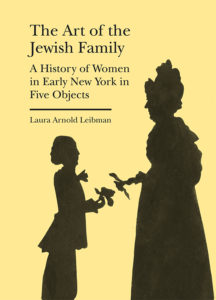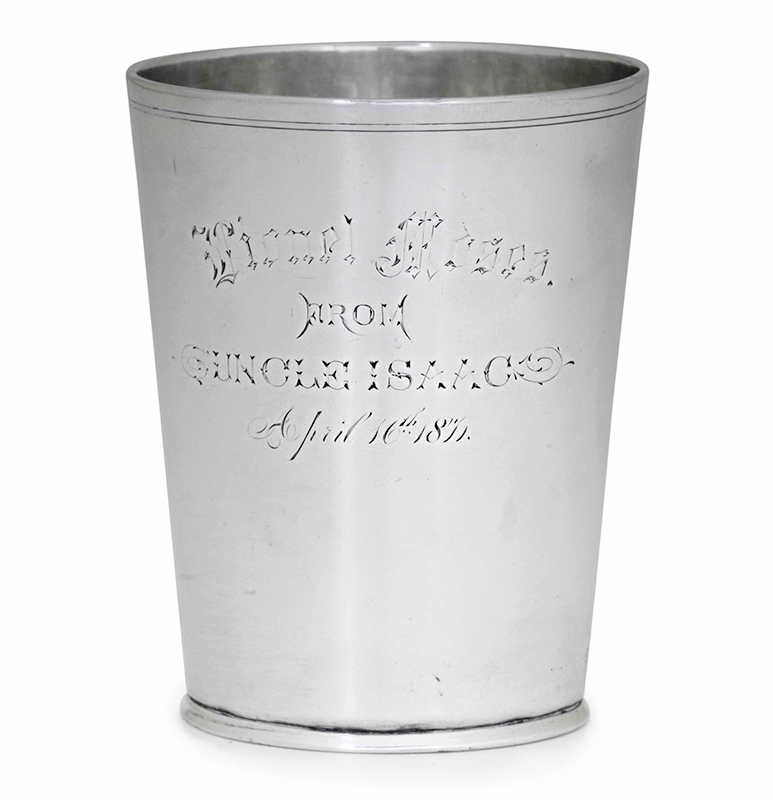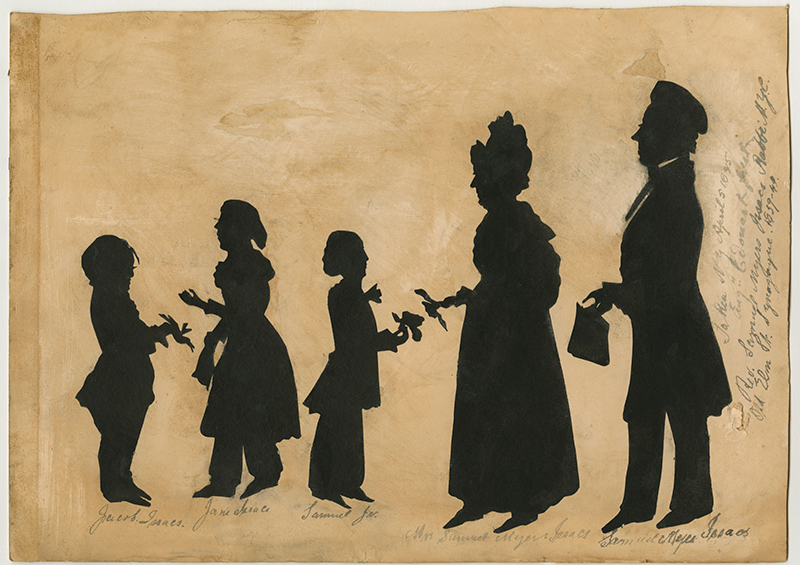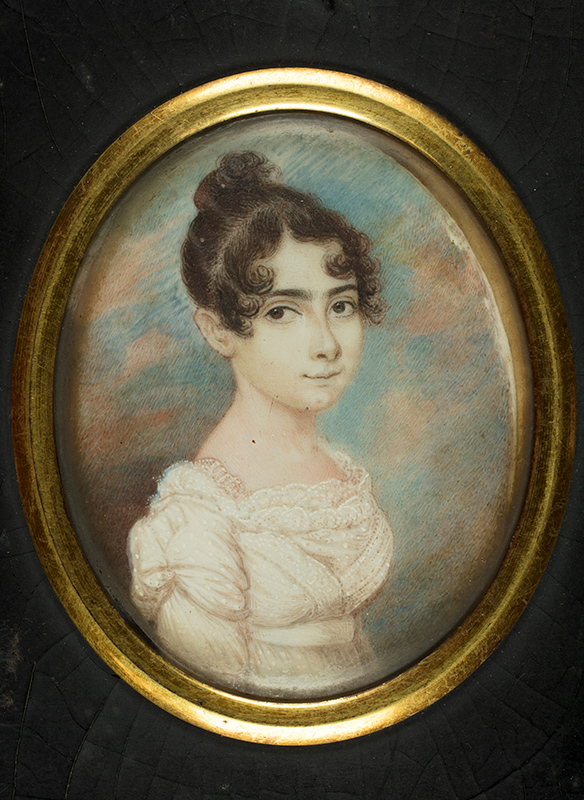Building a History of Early American Jewish Women from Objects: Laura Arnold Leibman’s ‘The Art of the Jewish Family’
by Kate Burnett Budzyn
 Laura Arnold Leibman’s The Art of the Jewish Family: A History of Women in Early New York in Five Objects, published in 2020 by Bard Graduate Center, is a history drawn from material fragments. Acknowledging the paucity of records relating to the lives of pre-1850s Jewish American women, Leibman masterfully finds her way into their neglected stories by considering the objects they owned. She selects five rare things to represent the lives of five generations of Jewish women in New York—a letter, a set of silver beakers, a miniature portrait on ivory, a “commonplace book,” and a family silhouette—and thus resurrects more than a century of diverse women who have largely been left behind by history.
Laura Arnold Leibman’s The Art of the Jewish Family: A History of Women in Early New York in Five Objects, published in 2020 by Bard Graduate Center, is a history drawn from material fragments. Acknowledging the paucity of records relating to the lives of pre-1850s Jewish American women, Leibman masterfully finds her way into their neglected stories by considering the objects they owned. She selects five rare things to represent the lives of five generations of Jewish women in New York—a letter, a set of silver beakers, a miniature portrait on ivory, a “commonplace book,” and a family silhouette—and thus resurrects more than a century of diverse women who have largely been left behind by history.
Taking up Jewish women’s everyday belongings as her source material, Leibman works to “recenter Jewishness in the family rather than the synagogue,” whose male-centered documents have provided the vast majority of evidence upon which early American Jewish history has been based. At the same time, she invokes archival scholar Marisa Fuentes and recognizes these objects’ rarity itself as essential evidence. Taking “a structural approach to silence,” the book looks closely not only at remaining objects, but also at the losses and deletions that surround them. Leibman teaches us to wonder why we have accepted the absence of Jewish women in our understanding of colonial America and the early republic. “Sometimes silence itself must testify,” she writes, leaving us to consider all the material evidence of Jewish domestic lives that has not made it into prominent decorative arts collections. Four of the book’s five central objects come from the collection of the American Jewish Historical Society, suggesting that secular cultural institutions have neglected to collect or adequately identify Jewish women’s quotidian objects and have thereby skewed the material record: “When we ignore things owned by Jews that can activate Jewish identity but in a secular or not explicitly religious context, we significantly limit what it means to be a “Jewish object” in ways that—at least in the eighteenth century—favored men.”
Leibman is a professor of English and humanities at Reed College, and her skill at attending to the subtleties of language is clear from the book’s start. She begins with a short, piercing 1761 letter written by Hannah Louzada, an impoverished and disabled Sephardic widow seeking financial help from her congregation, Shearith Israel, New York’s oldest synagogue. Leibman offers a masterful close reading that opens up worlds contained in a scant few lines. The author accepts the inherent risk in presenting a written document as the book’s first major piece of material evidence, but, in doing so, Leibman demonstrates her eminent ability as an interpreter while also showcasing the rewards to be had in treating rare scraps with meticulous attention. She moves seamlessly between snippets of colonial American English, Hebrew and baroque Spanish, using both paleography and close reading not only to return a bit of Louzada’s life to history, but also to extrapolate larger histories of the struggles faced by the Jewish women who migrated between Europe and the Americas in the early to mid-18th century. Leibman’s care with the document is stunning. She provides the kind of revelatory interpretation of seemingly minor details that keeps one eager for the next page of exegesis. Although the analysis around Louzada’s one-time status as an enslaver (of two household servants, Jenny and Tom) is scant and open-ended, the chapter leaves the reader with a sense of the profound costs of physical disability, mental illness, and primogeniture laws on early Jewish American women’s everyday lives.
Having shown what it means to really read something, Leibman turns to four thingier things. A set of late-18th-century silver cups made by renowned silversmith Myer Myers for his niece, Reyna Levy Moses, is passed down through generations as a “threshold gift” and demonstrates women’s central roles in creating and preserving Jewish families’ stories of themselves and their ancestors. Sarah Ann Hays Mordecai’s 1820s–1890s commonplace book—an “archetypal early American genre,” a kind of interactive scrapbook in which women collected and shared drawings and poems—shows us the importance of women’s work in creating both hetero- and homosocial networks of Jewish community through the exchange of craft, literary knowledge, and emotion. An 1845 family portrait by New York’s most prolific silhouette artist, Auguste Edouart, depicts a young matriarch, Jane Isaacs, pregnant and at the center of her growing family. The figures’ head coverings, hairstyles, and poses are revealed through Leibman’s visual analysis to signify the Isaacs family’s proud participation in the city’s new Ashkenazi Orthodox movement, which the author argues countered the rising Reform movement by encouraging women to remain actively involved as moral leaders in their families, congregations, and communities.
Apart from Louzada’s letter, the book’s most striking object is a c. 1815–16 miniature portrait of Sarah Brandon Moses, a woman of mixed racial heritage who was born enslaved in Barbados. Leibman takes us through the ivory miniaturist’s painstaking process of applying watercolor to thin sheets of elephant tusk in order to render luminous white skin tones. In doing so, she interrogates the process of “racecraft” through which many early-19th-century Jews (and white Americans writ large) codified their place within an increasingly rigid and dichotomous racial hierarchy. Leibman reasons that by commissioning and sitting for this tiny portrait, Moses helped establish herself as a marriageable member of the Jewish elite and propelled herself beyond the racial limitations presented by her history of enslavement.
The author interprets these five objects’ materialities with exquisite sensitivity, but the book also moves quickly. The Art of the Jewish Family rewards the reader with a thrilling sense that these women’s lives—despite the parts that have been lost—are universally relevant and urgently needed within our understanding of this nation’s early objects. Leibman achieves that alchemy that the major historians of underrepresented lives (Ulrich, Hartman, Lepore) keep assuring us is possible: fragments become full, compelling histories when there is someone to read them with great care.
Learn more about The Art of the Jewish Family: A History of Women in Early New York in Five Objects and watch an interview with Laura Arnold Leibman on the Bard Graduate Center website.
Kate Burnett Budzyn is a contributing writer to The Decorative Arts Trust Bulletin. She researches historic clothing and textiles and is the book review editor at Winterthur Portfolio.
About The Decorative Arts Trust Bulletin
Formerly known as the "blog,” the Bulletin features new research and scholarship, travelogues, book reviews, and museum and gallery exhibitions. The Bulletin complements The Magazine of the Decorative Arts Trust, our biannual members publication.








![“Application for assistance from Hanna[h] Louzada, New Brunswick, N.J.,” Nov. 9, 1761. Papers of Jacques Judah Lyons, P-15. Courtesy of the American Jewish Historical Society.](https://decorativeartstrust.org/wp-content/uploads/2021/05/lyons-letter.jpg)

![Sarah Ann Hays [Mordecai], Flower Basket, in her commonplace book (1823–94). Courtesy of AJHS.](https://decorativeartstrust.org/wp-content/uploads/2021/05/hays-flower-basket.jpg)

